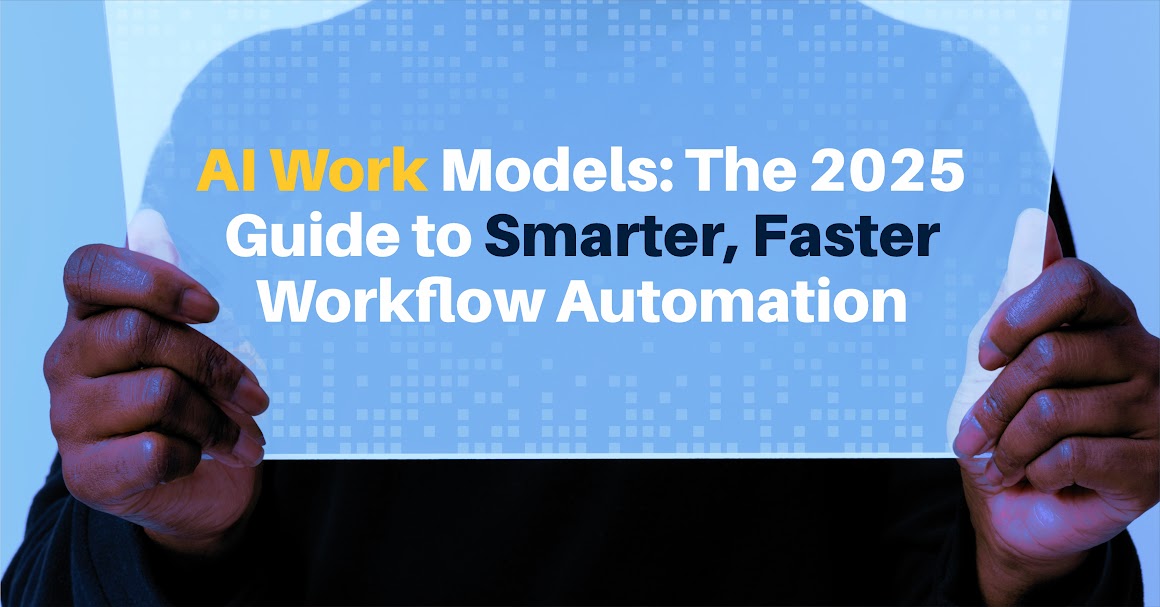Discover AI Work Models in 2025—your guide to smarter, faster workflow automation. Learn how purpose-built AI is transforming business efficiency.
- AI work models are digital teammates designed for specific business tasks (finance, HR, customer service, operations, sales, strategy) that go beyond chatbots by executing workflows end-to-end.
- Key benefits include faster cycle times, reduced costs, improved accuracy, and instant scalability, which help businesses stay competitive in a high-pressure global market.
- AI Work’s suite (Freddie AI, Yumi AI, Luca AI, Hermes AI, Orion AI, Olympus AI) offers plug-and-play automation for accounting, support, recruitment, logistics, market insights, and business intelligence.
- Best practice: start small with high-volume, rule-based workflows, keep humans in the loop for sensitive decisions, and track ROI through clear KPIs.
- Future trend: Businesses that adopt AI work models early will set the new productivity standard, while laggards risk falling behind.
AI is transforming how businesses operate in 2025. Beyond chatbots and generic assistants, companies are now adopting AI work models, specialized AI systems designed to handle real business tasks.
These models reduce costs, save time, and improve decision-making across finance, HR, customer service, operations, sales, and more. This guide explains AI work models in clear, practical terms and shows how business leaders can leverage them to achieve smarter, faster growth.
As Eric Bai, an AI work model expert and founder & CEO of Alpharithm Investments, puts it:
“AI work models are not just tools; they are the new digital teammates. They allow businesses to achieve more with fewer resources, while keeping human creativity at the center of growth.”
His vision underpins why AI Work’s models are built to help companies scale smarter, faster, and more efficiently. What follows is a detailed, practical guide tailored for business owners who want to understand not just what AI work models are, but how to implement them in real-world scenarios.
Table of Contents
Why AI Work Models Matter in 2025
The pressure to do more with less
Customers expect lightning-fast responses. Teams are stretched. Competition is global and relentless. The gap between companies that master AI and those that don’t is widening fast.
- Save time: Automate repetitive work so teams focus on strategy, creativity, and growth.
- Cut costs: Reduce hours wasted on routine tasks and minimize rework from human error.
- Boost accuracy: Apply rules consistently; log decisions automatically for audit and compliance.
- Scale instantly: Handle surges without hiring sprees or overtime.
- Enhance competitiveness: Early adopters raise the bar for service quality and speed.
Mainstream coverage reflects the same trend. As Reuters reported in 2024, “the types of business which are most likely to use artificial intelligence are seeing growth in workers’ productivity that is almost five times faster than elsewhere.” Reuters
Meanwhile, McKinsey estimates the global economic impact of generative AI at $2.6–$4.4 trillion annually, evidence that AI isn’t just tech hype; it’s a durable productivity engine across functions and industries. McKinsey & Company
What Are AI Work Models?
Simple definition (no jargon)
AI work models are like digital teammates built for specific business roles, processing invoices, screening job candidates, resolving customer requests, forecasting demand, or monitoring markets. Unlike chatbots that merely answer questions, these models execute multi-step workflows, end-to-end.
Think of them as AI-powered employees who never sleep, always follow policy, and scale instantly with business needs.
Key difference: While general AI assistants help you think, AI work models help you do.
Other automation paradigms exist, but AI Work Models go further:
- AI Work Models Vs. RPA (Robotic Process Automation): RPA follows rigid, rule-based scripts. AI Work Models adapt to real-world data, exceptions, and evolving policies.
- AI Work Models Vs. Copilots: Copilots suggest drafts or insights; AI Work Models execute full workflows end-to-end, with measurable outputs.
- AI Work Models Vs. AI Agents: Agents handle single, narrow tasks. Work Models manage ongoing business processes with governance, audit trails, and human-in-the-loop controls.
Anatomy of an AI work model
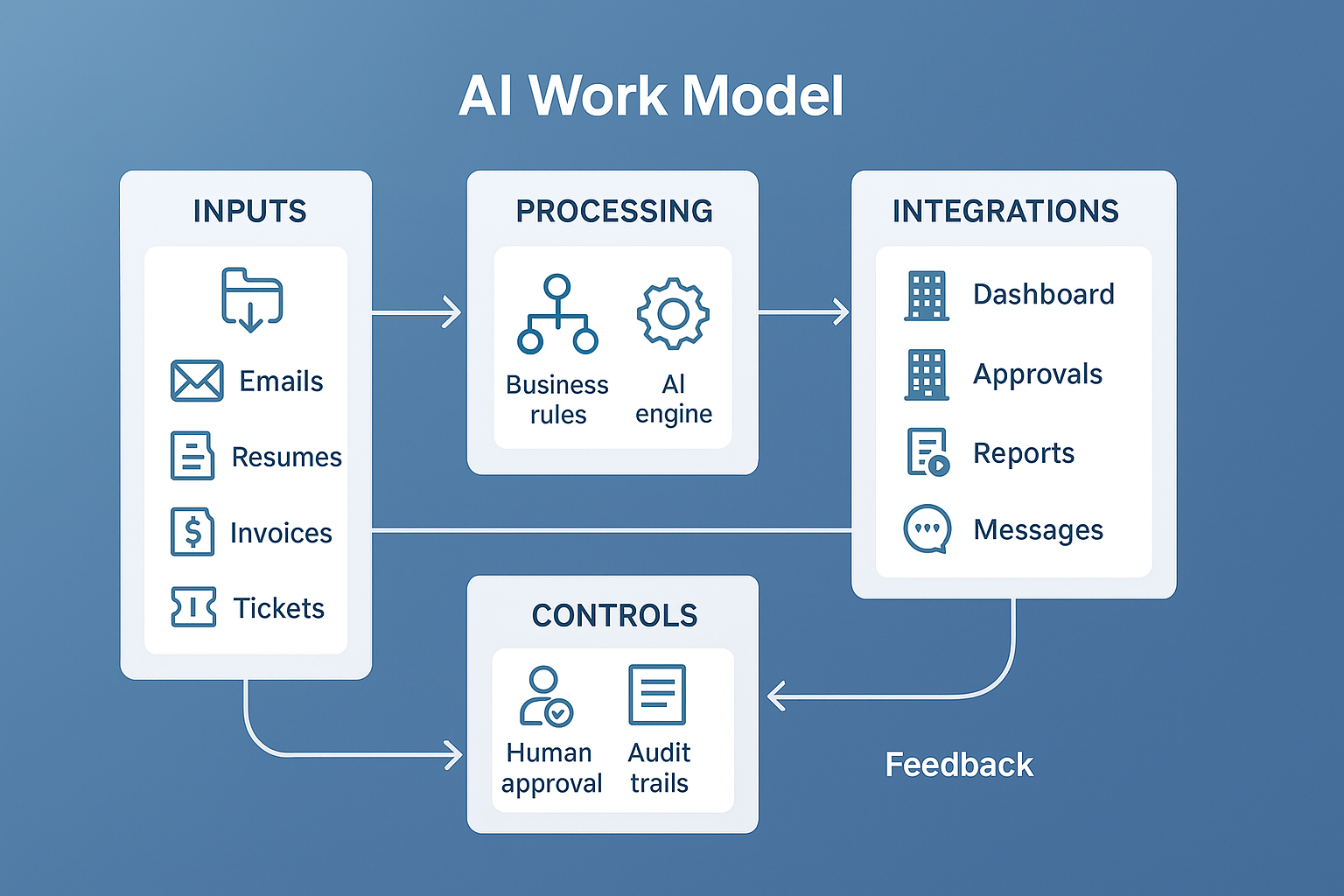
The anatomy of an AI Work Model shows how data flows from start to finish. It takes inputs like emails, files, and forms, applies smart business rules, and works with tools like CRMs and ERPs to get things done. The model produces dashboards, personalized replies, ranked lists, and purchase orders, while built-in checks like human approvals and audit trails keep everything accurate, secure, and under control.
Elastic scale: If 50 or 500 customer queries land at once, your model can process them in parallel without breaking a sweat.
Types of AI work models (and when to use each)
- Transactional models: Execute rule-heavy, repeatable tasks (invoice posting, refund processing).
- Analytical models: Synthesize signals, spot anomalies, generate insights (churn risk, cash-flow forecasts).
- Agentic models: Plan and take multistep actions across systems (triage support, orchestrate onboarding, run close-of-month checklists).
Is AI Work the Best AI Work Model in 2025?
In 2025, businesses face intense pressure to achieve more with fewer resources, and AI work models have become the new standard for efficiency. Among the available options, AI Work stands out to enterprises and fast-growing teams.
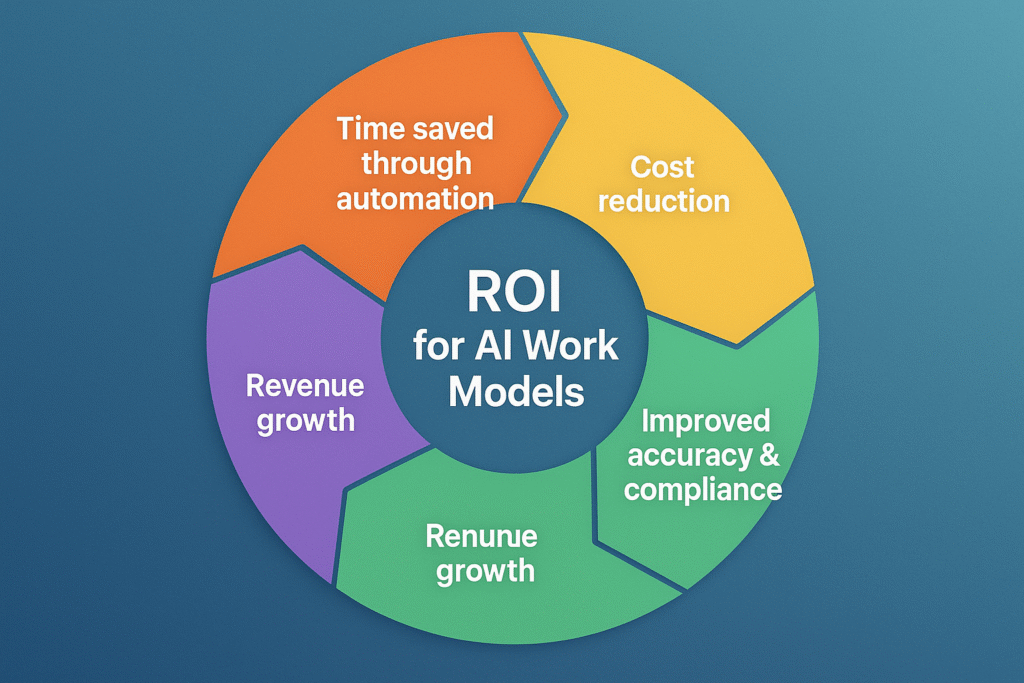
Why AI Work stands out:
- Rapid ROI: Organizations often see measurable improvements within weeks, not months, because models are pre-trained for specific roles.
- Ease of deployment: AI Work is cloud-based, enabling teams to start automating workflows quickly.
- End-to-end workflow automation: Handles repetitive tasks while integrating seamlessly with existing systems.
- Cost reduction & efficiency: Shortens cycle times and reduces manual errors.
- Scalable without heavy infrastructure: Can expand across departments and processes without complex IT requirements.
Other solutions like Microsoft Copilot, UiPath, and IBM WatsonX serve particular needs, but none combine ease of use, deep specialization, and fast ROI the way AI Work does.
For businesses that want immediate results without unnecessary complexity, AI Work stands as the best AI work model in 2025.
Top AI Work Models to Streamline Your Workflow
When it comes to workflow automation, not all AI tools are created equal.
What makes AI work models powerful is their specialization. Instead of being generic assistants, they are designed for specific roles in a business, like finance, HR, customer service, or operations. That specialization means they can deliver faster value with less setup, acting as digital teammates that handle real work.
Freddie AI: AI-Powered Recruiter for End-to-End Hiring
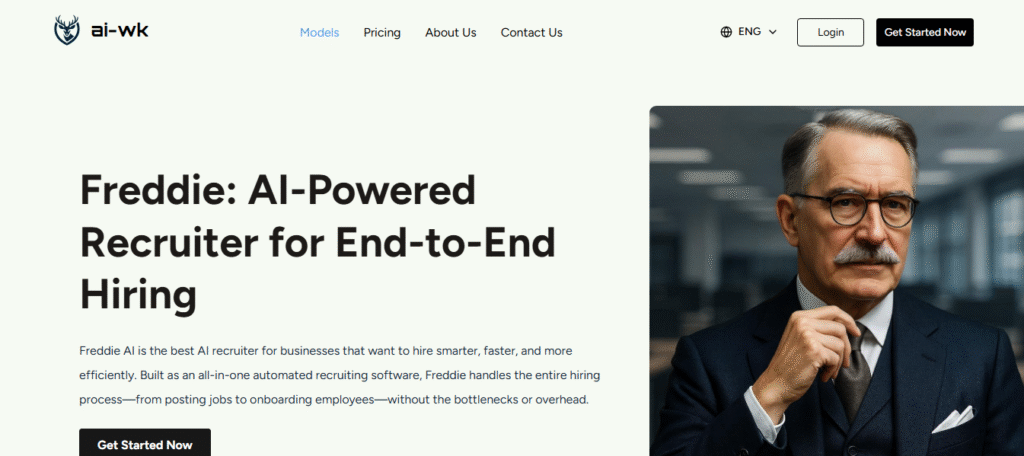
Finance leaders know the grind of month-end close, reconciliations, and endless expense checks. Freddie AI automates accounts payable (AP) and accounts receivable (AR), ensures reconciliations are accurate, runs expense compliance checks, and manages approvals in line with company policy.
By reducing manual journal entries and shortening close cycles, Freddie AI frees finance teams to spend more time on strategy and analysis instead of repetitive tasks.
Yumi AI: AI-Powered Customer Service Concierge
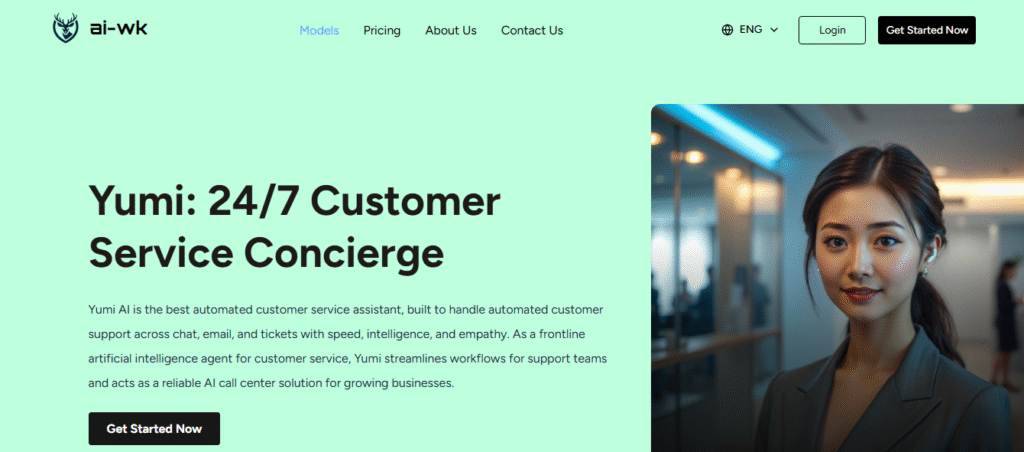
Customers expect fast and consistent service. Yumi AI serves as the first line of defense by triaging, resolving, or escalating queries. It applies the refund and policy rules without bias, ensuring every customer gets the same level of service.
Better still, every action is logged for quality assurance and compliance, giving managers full visibility.
The result: happier customers and less strain on support staff.
Luca AI: AI Accountant & Bookkeeper
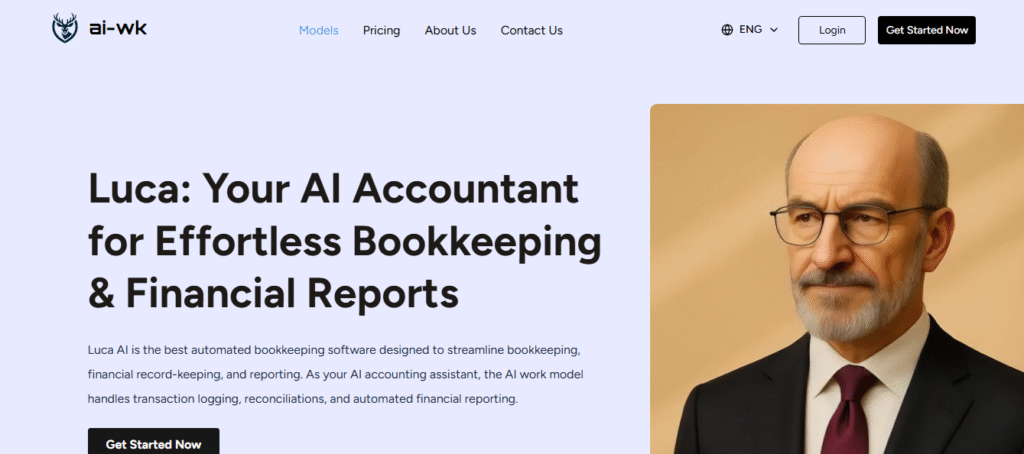
Recruiters and HR managers often drown in CVs and repetitive requests. Luca AI takes on the heavy lifting, drafting job descriptions, screening resumes for skills rather than superficial proxies, and handling routine HR questions like leave approvals or policy clarifications.
Importantly, it operates with human oversight, keeping people in control of hiring and HR decisions while reducing bias and wasted time.
Hermes AI: AI-Powered Market News Monitor
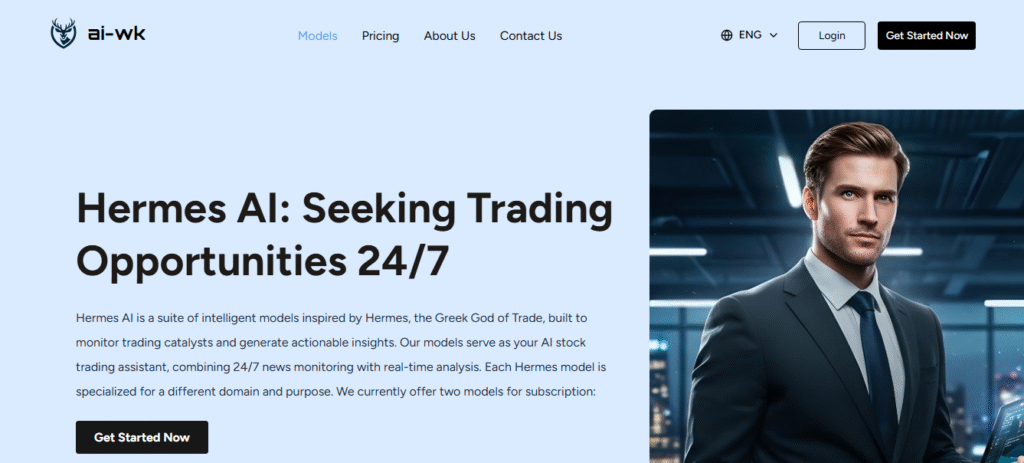
For manufacturers, retailers, or logistics companies, the biggest challenge is balancing supply and demand. Hermes AI forecasts inventory needs, flags supply chain risks before they become crises, and automates reporting. This makes it easier to avoid costly stockouts or overstocking, helping businesses stay lean and resilient.
Orion AI: AI Equity Research Analyst
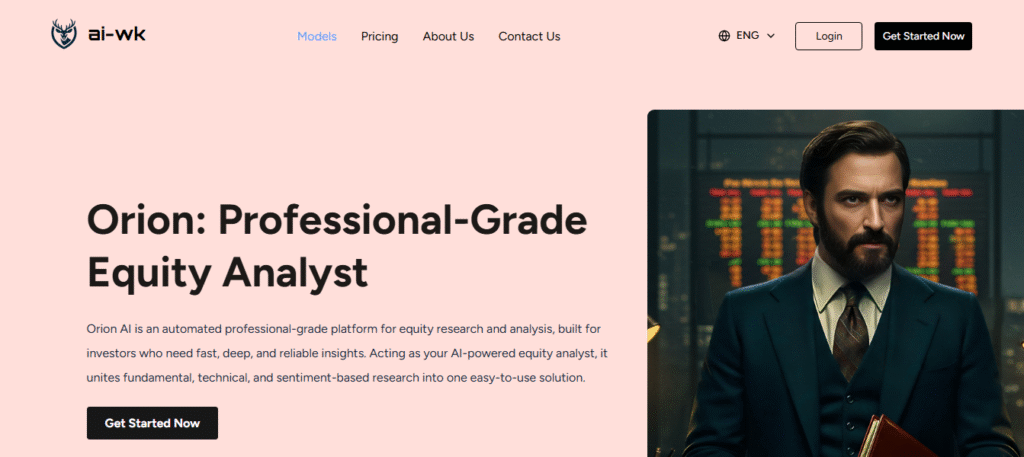
Markets move fast, and analysts can’t read every filing or track every competitor. Orion AI monitors markets in real time, scans company reports, and produces structured briefs. It’s like an extra pair of eyes for your investment or strategy team, surfacing insights before competitors catch on.
Olympus AI: AI Stock Market Simulator
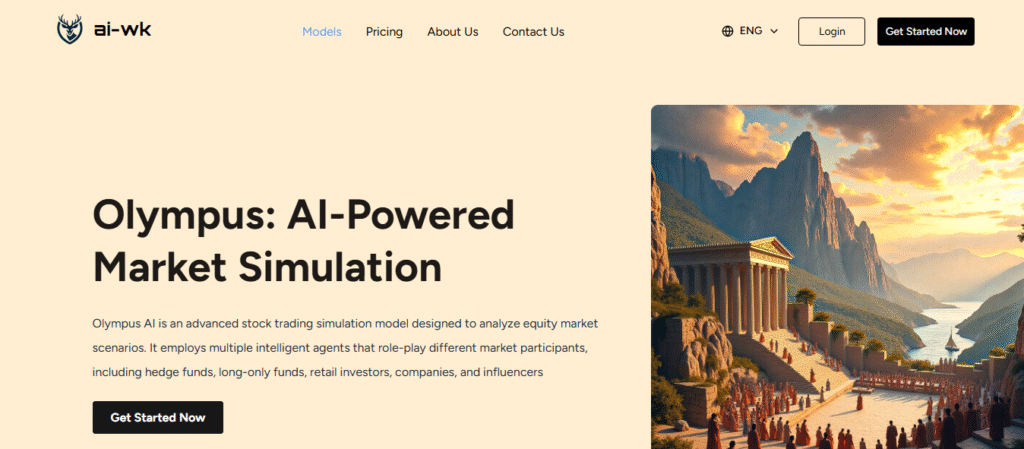
Executives need clarity, not noise. Olympus AI consolidates financial, operational, and market data into easy-to-read dashboards and decision memos. It aligns teams around key metrics and helps leaders steer strategy with confidence.
Together, these models are plug-and-play solutions. They don’t require months of setup or a large data-engineering effort. Instead, they slot neatly into existing workflows, so businesses can start seeing value and ROI almost immediately.
Where AI Work Models Deliver ROI (By Function)
1) Finance & Accounting
What AI Work Models Can Automate
- Invoice capture, three-way matching, and exception routing
- Vendor verification and fraud checks
- Bank reconciliations and period-end close tasks
- Expense policy checks with automatic feedback to employees
- Cash-flow forecasting and variance analysis
Try these AI Work Models:
- Freddie AI handles end-to-end accounting workflows, from invoice intake to ERP posting and reconciliation.
- Orion AI monitors markets and surfaces macro/sector signals that influence treasury and hedging.
- Olympus AI consolidates P&L, balance sheet, and cash metrics into role-based dashboards.
Example impact: A retail chain shortened its monthly close by ~40% with Freddie AI by eliminating manual entry and auto-resolving common exceptions.
Reasons to Try the Models
Firms are moving quickly. McKinsey notes that broadening adoption and tangible benefits were deployed, while the overall economic upside continues to be measured in trillions. McKinsey & Company+1
2) Customer Service
What AI Work Models Can Automate
- Ticket triage, routing, and response generation
- Refunds and replacements policy
- SLA tracking and proactive customer updates
- Knowledge-base search and personalization
- Sentiment detection and escalation to humans
Try these AI Work Models:
- Yumi AI delivers instant first-line responses and consistent policy enforcement.
- Olympus AI tracks backlog, AHT, FCR, and CSAT, highlighting bottlenecks.
Example impact: A travel agency cut average time-to-response from 48 hours to <3 Hours after deploying Yumi AI to handle routine queries and automate follow-ups.
Industry context: The Wall Street Journal recently profiled how AI bots are taking on the “busy work” across IT and support, saving large organizations millions by cutting downtime and license waste, underscoring the tangible ROI when you target the right tasks. The Wall Street Journal
3) Hiring & HR
What AI Work Models Can Automate
- Job description drafting and internal approvals
- CV screening and shortlisting by skills evidence
- Interview scheduling and candidate communications
- Onboarding paperwork and policy Q&A
- Leave requests, benefits questions, and HR ticketing
Try these AI Work Models:
- Luca AI automates sourcing and screening with auditable rationales.
- Olympus AI surfaces trends in attrition, time-to-hire, offer acceptance, and DEI measures.
Example impact: A logistics firm saved 120+ HR hours per month by automating screening and scheduling, while increasing interview-to-offer rates.
Caution: Mainstream reporting emphasizes that human oversight remains essential, especially in sensitive decisions like hiring and performance management. The Financial Times notes that while AI is transforming HR workflows, legal and regulatory risks require careful governance and a human in the loop. Financial Times
4) Operations & Supply Chain
What AI Work Models Can Automate
- Demand forecasting, reorder suggestions, and supplier risk alerts
- Exception-based scheduling and logistics tracking
- Quality control analytics and yield optimization
- Daily operational reporting and KPI reviews
Try these AI Work Models:
- Hermes AI predicts demand, flags anomalies, and suggests stocking changes.
- Olympus AI aggregates OTIF, inventory turns, and lead times into executive dashboards.
Example impact: A manufacturer cut stockouts by ~30% by combining Hermes AI forecasts with disciplined replenishment rules and vendor scorecards.
5) Sales & Marketing
What AI Work Models Can Automate
- Lead scoring and enrichment
- Personalized outbound and next-best-action suggestions
- Campaign generation and A/B test orchestration
- Pipeline health and forecast accuracy alerts
Try these AI Work Models:
- Orion AI identifies customer/market trends and crafts targeted campaign angles.
- Olympus AI consolidates CRM and marketing analytics into simple, role-specific views.
- Yumi AI follows up with warm leads and trial users automatically.
Example impact: A software company doubled open rates by using Orion AI to tailor messaging to segment-level signals and Olympus AI to track the deltas.
Build vs. Buy: Should You Buy or Build AI Work Models?
Quick rule of thumb
- Buy when the workflow is common (AP, support triage, CV screening). You’ll live faster at a lower cost.
- Build when the workflow is unique and central to your competitive advantage (proprietary risk models, specialized underwriting, custom ops).
- Blend both: adopt reliable off-the-shelf models as a base, then extend with custom logic where it matters.
Total cost of ownership (TCO) factors
Direct costs
- Licenses or usage fees
- Implementation and integration effort
- Data engineering (pipelines, cleaning, labeling)
- Change management and training
- Monitoring, security, and compliance
Hidden costs
- Delay cost (lost savings while you build)
- Model drift and maintenance
- Vendor lock-in vs. multi-vendor complexity
Tip for SMBs: Start with buy to capture quick wins and preserve capital; layer customization later.
Tip for enterprises: Build where differentiation is real; standardize the rest.
AI Work Model vs. AI Agent
AI agents are great at handling specific, one-off tasks, think of a travel bot that books a flight or a scheduling assistant that finds a calendar slot. They’re useful, but limited in scope and usually don’t carry business accountability.
AI work models take it further. Instead of just booking a flight, they can own the entire workflow, from validating travel policies, to processing approvals, to logging expenses in your ERP. They’re designed with audit trails, guardrails, and human-in-the-loop options, making them a fit for real enterprise operations.
AI Work Model vs. Copilot
Copilots (like Microsoft Copilot or GitHub Copilot) act as sidekicks. They draft, suggest, and speed up your work, but the human is always in the driver’s seat. You approve every line of code or every email before it goes out.
AI work models are closer to a digital teammate. They don’t just suggest; they execute. Instead of drafting a sales follow-up, they can send the email, track replies, and escalate only when something unusual happens. Copilots help you think, but AI work models help you get the work done.
AI Work Model vs. RPA (Robotic Process Automation)
RPA excels at automating simple, rule-based tasks within legacy systems, copying this field, pasting that value, and generating a report. It’s powerful, but brittle. As soon as an exception appears (an email, a PDF, or a policy nuance), the script breaks.
AI work models combine automation with intelligence. They can read unstructured data, apply judgment based on policies, and adapt when exceptions come up. Where RPA bots might fail silently, AI work models log every action, involve humans when needed, and keep improving with use.
AI Work Model Implementation Playbook: From Pilot to Scale in 90 Days
Phase 1: Target value like a sniper (Weeks 0–2)
- Map the workflow: Where is time wasted? Where do errors happen?
- Quantify the baseline: Volume, SLA, AHT, rework rate, cost per transaction.
- Pick one high-yield use case: Low risk, measurable outcomes, clean data source.
- Define “done” metrics : e.g., 30% faster resolution, 20% fewer escalations, <1% error rate.
Phase 2: Prepare your data (Weeks 1–3)
- Identify systems of record (ERP, CRM, HRIS, ticketing).
- Secure access via service accounts; restrict PII exposure.
- Create golden datasets for testing and regression checks.
- Standardize labels (e.g., “Refund_Eligible,” “Escalate_KYC,” “Duplicate_Ticket”).
Phase 3: Pilot with guardrails (Weeks 3–6)
- Start shadow mode: model drafts actions; humans approve.
- Track precision/recall and SLA effects.
- Iterate prompts, rules, and escalation policies weekly.
- Document edge cases that need deterministic logic.
Phase 4: Go live with human-in-the-loop (Weeks 6–8)
- Enable automatic execution under thresholds (e.g., refunds < $100).
- Keep approvals for high-risk actions.
- Turn on immutable audit logs (who/what/when/why).
- Establish rollback procedures (revert batch if error > threshold).
Phase 5: Expand and industrialize (Weeks 8–12)
- Add the next two adjacent workflows (e.g., after AP, tackle expense audits; after support triage, add order status automation).
- Integrate dashboards into daily standups.
- Formalize an AI Change Advisory Board (AI-CAB) for ongoing governance.
Adoption is accelerating. McKinsey’s 2025 survey shows a sharp uptick in organizations using AI in at least one business function, up from the prior year, evidence that companies are moving from experiments to embedded use. McKinsey & Company
Metrics That Matter: Proving ROI
Operational KPIs
- Cycle time (e.g., close days, ticket resolution time)
- First-contact resolution (FCR) and average handle time (AHT)
- Backlog and on-time completion
- Exception rate and rework rate
Quality & risk KPIs
- Error rate (policy violations per 1,000 actions)
- Escalation rate and false positive/negative rates
- Customer satisfaction (CSAT/NPS)
Financial KPIs
- Cost per transaction
- Hours saved per month
- Working capital improvements (DSO/DPO)
- Revenue lift from better personalization or faster cycle times
Tie each model’s success to a single owner and review results weekly. Winners get scaled; laggards get fixed or retired.
AI Work Models Real-World Case Studies
Finance (Healthcare provider)
- Challenge: AP cycle times ballooned; manual invoice matching caused 2–3 day delays.
- Solution: Freddie AI for intake, three-way match, and approvals under thresholds.
- Result: Invoice time dropped from ~8 minutes to ~2, saving 400+ hours monthly; a clean audit trail reduced external audit queries by 30%.
Customer Service (Regional bank)
- Challenge: Long queues, inconsistent responses, rising complaint volume.
- Solution: Yumi AI triage + Olympus AI service dashboard.
- Result: 60% reduction in wait times, 22% lift in CSAT; policy-sensitive issues escalated to human specialists.
HR (Recruitment firm)
- Challenge: Manual CV screening and bias concerns.
- Solution: Luca AI for skills-based shortlisting with auditable rationales.
- Result: Screening time cut from days to hours; higher diversity in shortlists without sacrificing fit; recruiter satisfaction up.
Sales (E-commerce brand)
- Challenge: Stagnant email engagement and poor segmentation.
- Solution: Orion AI for trend insights and persona messaging + Yumi AI for personalized follow-ups.
- Result: 15% lift in conversions; revenue per email up; better pipeline visibility via Olympus AI.
Broader context: Major outlets continue to document enterprise wins. The WSJ reported AI automation saving “millions” in IT lifecycle management at Broadcom, proof that well-aimed AI work models create measurable value. The Wall Street Journal
Common Roadblocks (and How to Beat Them)
Our data is too messy
Start with one system of record and a narrow use case. Use transformation rules at the edge (intake clean-up) and standardize labels. You don’t need a perfect data warehouse to start saving time.
Teams are skeptical
Start in shadow mode, let humans approve, and publish side-by-side metrics (before vs. after). Celebrate the wins of the people using the model; adoption follows proof.
We’re worried about bias and compliance
Good. Keep humans in the loop for sensitive decisions, and invest in QA and auditability. Document every policy. The FT has emphasized that oversight is non-negotiable in HR; the same logic applies elsewhere. Financial Times
Will this replace jobs?
AI redistributes work first. Over time, roles evolve. Focus on task automation, upskill your people into exceptions, quality, relationship-building, and analysis.
For perspective, Reuters reported clear productivity surges where AI is used most intensively; companies that harness this early will outpace competitors. Reuters
The Future of AI Work Models
- Multimodal, hands-on AI: Models won’t just read text; they’ll see documents, listen to calls, and act across your stack end-to-end.
- Seamless integration: Expect native connectors to the tools you already use: ERPs, CRMs, HRIS, so you can deploy faster with less custom plumbing.
- SMB-friendly pricing: Competition and scale will keep bringing prices down, opening the door to sophisticated automation for smaller teams.
- Industry-specific depth: Healthcare, legal, logistics, and finance domain models will embed regulations, ontologies, and best practices by default.
As Eric Bai explains:
“The future of work will be defined by the partnership between humans and AI. Businesses that adopt AI work models early will set the new standard for productivity, while those who hesitate risk being left behind.”
FAQs
What is an AI Work Model?
How are AI work models different from chatbots?
What’s the Difference Between AI Work and AI Work Model?
Do I need large datasets to get started?
Do I lose control?
What if my team resists?
What about bias and compliance?
How fast can we see results?
What KPIs should we watch?
What skills will my team need?
Where should we start?
AI Work Models in 2025: Final Thoughts
AI work models are practical, scalable, and ready to integrate today.
You don’t need deep technical skills; they’re designed to plug into your workflows and get things done. Start small, measure results, and expand step by step. Focus on business value, not buzzwords. Keep people in the loop, build clear guardrails, and celebrate the wins as they come.
If you want a head start with tools designed for real-world work, explore AI Work’s suite of purpose-built work models, including Freddie AI, Yumi AI, Luca AI, Hermes AI, Orion AI, and Olympus AI, and turn them into your smartest teammates.

